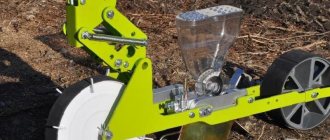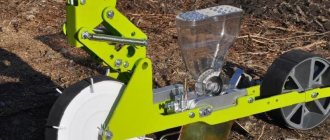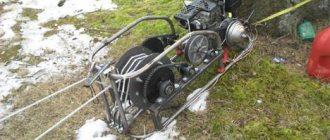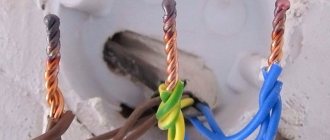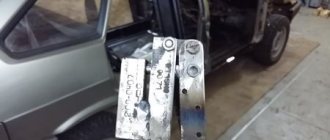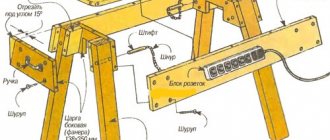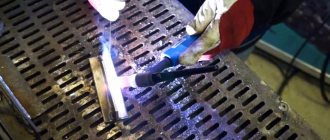Types and benefits of using a carrot seeder
Seeders made for manual sowing are divided into several types:
- Fertilizers - recommended to simplify the process of fertilizing or distributing lime throughout the territory;
- Garden - designed for sowing seeds for agricultural needs in areas near the house or vegetable gardens;
- Grain-cereals - provide for planting over vast areas - in grain fields.
A simple seeder can be made from scrap materials without spending much money. But all simple devices are made only for the hole, that is, adjusting the required volume of the hole is often problematic or almost impossible.
The advantages of such a device are:
- Uniform sowing of planting material;
- Placement at the same depth ;
- Equal distance between plantings;
- Easy to use;
- Ease of creation.
With the help of such a unit you can quickly and in a short time plant a large area. After working with a carrot seeder, you will not have to pull out excess seedlings, injuring those that remain for further growth.
Manual seed planter
This type of planting technology is used over vast areas. It is able to create even grooves and place an even amount of seeds in them. It can be used not only for sowing carrots, but also beets, onions, parsley, lettuce or other small seeds.
Manual carrot seeder
The groove is made through the movement of a wheel on which special blades or spikes are located. With these growths, the wheel creates holes of a certain size with the same depth.
The design of the seeder is such that a spout comes from the hopper, through which a certain volume of seeds is sown. The supply of seedlings is strictly regulated by a special valve.
At the back there is an additional wheel with a smooth surface, which, when moving, fills and compacts holes with planting material.
Piston
A piston carrot seeder looks like a cylindrical plastic container. Planting material is placed in it. At the bottom there is an adjustable conical hole for sowing seedlings into the soil. On top of this device there is a piston equipped with a spring.
Piston Carrot Planter
This unit works on the principle of squeezing a certain amount into a pre-prepared hole in the ground. To prevent seedlings from scattering in different directions, a piston seeder is placed 5 cm above ground level.
Some farmers consider the piston planter to be a problematic device, and replace it with an ordinary medical syringe. But working with a syringe causes a lot of inconvenience:
- When squeezing out seeds, they often scatter in different directions ;
- The pressure on the syringe cannot be controlled, so the seeds fall out in different volumes.
The piston planting system is designed for large areas, but with a syringe you can’t sow much. Therefore, it is better to use a piston with spring pressure.
Funnel-shaped
One of the simplest mechanisms is a large dispenser with a miniature “spout”. The cone, which goes into the ground, has a hole, the volume of which can be adjusted by the diaphragm located inside.
The funnel is placed above the soil surface at a height of up to 15 cm and the preparation is gently shaken . The seeds, rolling out along the groove, are evenly placed in the furrow.
Using such a funnel-bowl, it is possible to achieve correct, even furrows, without being thickened with an excessive amount of seeds.
The disadvantage is the need to adapt or adapt to such work . If you shake frequently or vigorously, you can plant the seeds not in the furrow at all, but around the entire area.
Carrot planter made from a block
This planting method is similar to the egg tray method. To make a planter from a block, you will need several plastic lids and a wooden block. Its dimensions can be arbitrary, but it is better to stick to the proven volume of a wooden board - 5x5x50 cm .
The lids are nailed on one side. The soil needs to be loosened well so that it is airy and soft. The top layer of soil is leveled evenly. The side with the lids is lowered into the soil and pressed . After the block is raised above the surface, even holes remain in the soil substrate for planting carrot seeds. All that remains is to insert the prepared seedlings and sprinkle.
Mini rake for planting seeds
Raking for planting is easy to do if you have previously had experience with a hacksaw or jigsaw. For the prepared bed, you should select a long board so that it completely covers the area.
Also, to produce a rake you will need a block of wood up to 20 cm long - this will be the handle.
Homemade rake for planting carrot seeds
The bottom side (end) must be cut. Peculiar teeth in the shape of a trapezoid are cut out on it, so that the lower base is no more than 1 cm, and the depth reaches 2 cm. A handle is placed in the center on the flat side. This can be done using a nail. The work on the mini rake is finished.
To perform sowing, you need to lower an improvised rake onto the dug up, airy area and move it around the perimeter. In an instant, smooth grooves are formed on the site into which planting material must be placed.
Constructions
All models introduce seedlings into the ground; they differ in the method of sowing. Spreaders and planting equipment are provided.
Operating principle of spreaders
There are two types of spreaders:
- Manual: seeds pour out through the holes when you turn the handle of the device; there is a built-in distributor inside. The ability to adjust the diameter of the holes allows us to classify the devices as universal. Usually made of plastic. They are used for spreading fertilizers, but mainly as a manual lawn seeder.
- Mechanical: there is no motor, but there is a moving part. Seeds fall into the ground by periodically pressing a button on the handle while moving. One or more containers for seedlings are attached to the axis.
The main disadvantage of spreaders is the unevenness of sowing, so they are rarely used for vegetables, more often as a disperser for lawn grass.
Precision Fitting Devices
To uniformly sow vegetables, precision sowing devices are used, created on the principle of transmitting torque from the wheel to the shaft:
- Simple: the device moves, the shaft with recesses rotates, the seed from the cone-hopper falls on it, lingers in the recess, and then falls into the prepared groove with a given step. The seeding density depends on the distance between the recesses.
- Complex: the principle of operation is the same, but additional devices are added. Blades or spikes are attached to the front wheel to create grooves during movement, while the rear wheel is made level, which allows you to level the ground after landing. The supply of seeds to the shaft is regulated by a valve, and the seedlings move from the hopper along a special spout .
They are suitable for crops with small seeds, just like a seeder for regular lawn grass.
Note! The device allows you to work in a comfortable position, increases the sowing speed, and the seeds are distributed evenly.
Recycled materials, jars or plastic bottles will be useful when making a simple version of the product, and iron sheets, wheels, etc. will be needed for complex designs.
Additional types of seeders
There are many methods for planting seeds. Carrot seedlings present the greatest difficulty for gardeners. They are quite small and difficult to plant evenly. After germination, a very large number of young shoots have to be removed. Therefore, it is recommended to use different methods for planting:
- Sowing with toilet paper - numerous seeds are glued to a piece of toilet paper in a random or strictly defined order. Later this area is covered with a small layer of earth. When the sprouts sprout, they do not need to be discharged. The only thing is that weeds sprout abundantly among them. The disadvantage of this method is the long-term gluing of small seedlings onto a piece of paper;
- A seeder from an egg container is an original and simple way. The advantages of this method are its simplicity and evenly planted seeds at the required distance. To do this, you need to press the tray into the ground and pour 1 or 2 seeds of planting material into the resulting holes;
- Using tape - in specialized stores you can find a special tape for planting carrots. The seedlings are already glued to it in the required order and at the optimal distance. Planting is easy - tape is applied to the furrow made and sprinkled with earth.
Thus, it is easy to plant carrots without a seeder at home, but before doing this you need to either spend money or be patient by placing small seeds on toilet paper. But to get a rich, and most importantly, even harvest, you can make any sacrifices.
Landing on the tape
There are different methods for planting carrots. One of them makes the work of gardeners much easier. It consists in the fact that planting is carried out on tapes that are sold in specialized stores. Seeds are already glued to them. How to plant carrots? The technology is very simple. Furrows are made in the beds, ribbons with seeds are stretched along them and sprinkled with soil.
You can make a device for planting carrot seeds yourself. To do this, take loose paper, maybe toilet paper. Strips are cut to the required width, usually two centimeters. A starch paste is prepared. It is applied in droplets, at a distance of 2.5 centimeters, onto the strip. A carrot seed is placed on top of each droplet.
To ensure a large harvest, fertilizer with a mineral composition is added to the water for preparing the paste. One tablespoon of the additive is enough per liter of water. To save time, wide paper is not cut into strips, but drops of glue are applied on both sides. Planting carrot seeds on tape has the following advantages:
- The sowing process is facilitated by the fact that all preparatory work is carried out at home and not in the field. Evenly spaced seeds on paper produce the same seedlings.
- The planting material is embedded in the ground to the same depth, as it is glued to one tape.
- Seed consumption is reduced by 20 times compared to the conventional sowing method, and the yield increases.
- The tape is a covering material for carrots, thanks to which it is protected from damage by carrot flies.
How to make a manual carrot seeder with your own hands?
In cases where there is no extra financial resources to purchase a seeder, you can make it yourself. Before work, you should draw up a drawing and an individual design of the future unit. It is best to do everything using simple models.
For production, an axle, aluminum tubes, and wheels, as well as iron, sheet format are required. From these parts you can make an excellent homemade seeder without resorting to heavy and costly technologies.
Scheme of a homemade seeder for planting carrots
Collection scheme:
- Aluminum tubes turn into handles. It requires measuring the angle of inclination and adjusting the height of the seeder to suit your height; it is best to design the handles “from yourself”;
- Seed bins are formed from iron in the form of cones or funnels. They are located on the axis so that there is a small space of 1 cm between them;
- Each funnel should go down like a sharp cone , inside of which there is a hole 0.1 cm wide;
- The central axle is connected to the wheels , the bins are placed on top of the axle, to which handles are attached;
- Additionally, if desired, you can install a limiter to mark the rows .
Thus, when using seeders, you can not only plant seeds in your garden or dacha with pleasure, but also spend less time. In addition, when working with such planting technologies, you do not have to remove excess shoots as the crop grows . If you follow the recommendations, you can make high-quality equipment with your own hands and plant large areas of not only carrots, but also other crops.
Do-it-yourself precision fit device
The model is made according to a drawing prepared in advance. A simple version is made from a plastic or metal round jar with holes in diameter, their size is for the seeds of the planted crop, a pusher handle and an axis of rotation.
Another option is an axle with attached two wheels, a shaft, a grain hopper and a pusher handle. Notches are drilled into the shaft, but not holes. The seeds fall out of the hopper and are evenly distributed throughout the row thanks to these depressions. It is better to make the bunker out of plastic so that you can see the number of seeds, but a box made of wood or metal will also work.
You can attach a coulter to form furrows; to level them and cover them with soil, use a piece of foam rubber or a hoe. If several bins are installed on the axis, the planting width will increase.
Important! Before sowing, adjust the planting depth, row spacing, and seedling consumption rate.
A homemade seeder allows you to plant different crops with small seeds, beets, phacelia, etc.
The small seed model is suitable for small areas or greenhouses. It speeds up and simplifies the planting process and is safe to use. Depending on the budget, the device is purchased or made independently. Spreaders are suitable for planting lawns and alfalfa; precision sowing or universal models are suitable for vegetables.
What is a carrot planter
A seed seeder is a special mechanical device, which, due to its design features, makes it possible to quickly and efficiently sow seed along a given trajectory.
The operating principle of such a device is quite simple:
- blades or special spikes are installed on the front part of the unit, with the help of which furrows of the required size will be formed;
- Along the width of the seeder, at a certain distance from each other, containers for seed material are installed;
- a hole is made at the bottom of such containers through which the required amount of seeds falls out, that is, into the soil;
- a smooth wheel attached to the unit fills the furrows and levels the soil.
- The vegetable seeder has a number of undeniable advantages, which include:
- acceleration of the process of sowing seed material;
- rational consumption of seeds;
- precision seeding, which makes it possible to simplify the care of seedlings in the future;
- simplicity and ease of use;
- no need to thin out seedlings.
Using the described device, it is possible to process a large area in a short period of time.
Main types and advantages of using a carrot seeder
Today, farmers have access to a wide selection of different planters, differing in size, operating principle, materials, etc. A description of the most common ones is given later in the article.
Manual planter
One of the simplest mechanical devices for large-scale sowing of seeds is considered to be a manual planter, which makes it possible to make uniform furrows and evenly “lay” a certain number of seeds into them. A similar unit can be used for sowing carrots, onions, beets, parsley, lettuce, spinach and other small seeds.
The manual planter operates according to the following principle:
- special blades and spikes are mounted on the wheel, which, when it moves, create holes of a certain, uniform depth;
- A bunker is installed in the middle of the device, into which seed material is poured;
- from the bunker there is a so-called “spout”, through which seeds are supplied evenly, with strict adjustment by a special valve;
- the rear wheel, in the direction of travel, fills the furrows with soil and compacts the soil.
Some models of hand planters can be equipped with several rows of blades for sowing seeds simultaneously in several furrows. They can also be supplemented with a function for adjusting the planting depth.
Video: Manual planter for carrots and vegetables
Piston seed planter
The piston type of seeders is a design consisting of a small plastic cylindrical container (glass) intended for laying seed material, and a small piston inside it, equipped with a spring. In this case, the supply of seeds is carried out by pressing the rod and squeezing out a certain amount of them “under pressure”.
- The advantages of a piston installation are:
- the ability to cultivate a large part of the territory;
- high efficiency when supplying seeds;
- ease of operation.
- However, many farmers note a number of disadvantages of the unit:
- uneven “squeezing out” of seed material;
- inability to form an even hole;
- the need for further thinning of seedlings.
Funnel planter
As a rule, a funnel-shaped planter is rarely used for sowing carrot seeds, since it is considered the best option for larger grains. It consists of a cone-funnel with a narrow spout through which seed material flows.
The funnel is placed above the ground, approximately 15 cm, and filled with seeds. Due to gentle shaking, the grains are uniformly rolled out along a special groove into the furrow. One of the disadvantages of the seeder is the difficulty in adjusting the amount of spilled seeds, as well as the need to thin out the sprouts.
Sowing carrots using egg cells
This method of sowing can be called the simplest, because it does not require any preparation or serious equipment.
Sowing carrots using egg cells is carried out as follows:
- Take two paper cells from under chicken eggs, designed for three dozen.
- They are placed one inside the other to make the structure stronger.
- They press it to the ground, forming patterns of holes where the seed is placed.
By sowing carrots using egg cells, you can achieve the optimal distance between seeds and then thinning will not be necessary.
Simple and original ways of sowing carrots will be a real boon for every summer resident. But for a good harvest, the plant must be regularly fertilized, weeded and watered.
Basic rules and criteria for choosing a finished model
If you can’t make a planter with your own hands for various reasons, you can purchase it at any construction market. However, when choosing a model, you should pay attention to such aspects.
- Productivity . The most effective devices are those with a trailed operating system, since they allow you to process a fairly large area of land. For sowing in small areas, it is more advisable to use manual units.
- Weight . Manual seeders are the lightest, which greatly simplifies the work process and does not overload the farmer. Towed devices carry the heaviest weight, and you need to get used to working with them.
- Functionality . Trailed devices have the richest functionality, which can be used not only for sowing seeds, but also for cultivating, loosening the soil, applying fertilizers, etc. Manual units are considered less functional.
- Adjustment options . Typically, the simplest manual models cannot compete with automated devices in terms of adjusting furrow depth and row width. Trailed planters are equipped with a function for adjusting these parameters, and also make it possible to change the size of the hole in the seed container, which significantly expands the range of seeds sown.
Today, manufacturers offer consumers a huge range of seeders that have excellent functionality, practicality and a long service life. Among the models that are popular with farmers are precision seeding devices “SOR-1/1”, “1001-V”, “SMK-1”, pneumatic models made in China and Poland, and trailing mechanisms made in China, Ukraine, and America.
How to make a carrot seeder with your own hands
A carrot planter is an excellent assistant in the agricultural industry, however, if it is not possible to purchase a model from the manufacturer, then you can make it yourself using available materials.
Dimensions and drawings
Before you start making a seeder, you need to draw up a drawing and design of the unit.
For independent production, experts recommend choosing the simplest models, drawings of which can be found on the Internet.
Each master can choose the design of a homemade seeder at his own discretion, however, the universal design includes three main components:
- container for laying seeds;
- a device that allows you to separate seed material from the total quantity;
- mechanism that covers seeds with soil.
Materials and tools for work
To make a device without resorting to large financial and time costs, you need to prepare the materials:
- a plastic tank for placing seed material;
- the axis on which the seed container will be located, for example, a bolt;
- a tube made of aluminum or plastic, as long as the depth of the tank, required for the seed material;
- metal pipe of the same size;
- steel wire;
- washers for securing parts;
- wooden handle, you can take a shovel handle;
- a steel sheet in the form of a hoe, for raking the soil after sowing seeds.
During the work you will need the following tools:
- sharpened knife for cutting plastic;
- measuring instruments: tape measure, level;
- saw for metal and wood.
Step-by-step manufacturing instructions
The process of producing a homemade planter is quite simple:
- A hole is drilled exactly in the center of the container.
- A triangle-shaped hole is made in the lid, which is necessary for filling the seed material.
- A valve is made from tin according to the size of the triangular hole, and it is secured in one of the corners using a screw and nut.
- A plastic tube is inserted into the hole made in the seed container, which will add strength when installing the handle and will prevent the seeds from spilling out.
- A piece of steel pipe is inserted into the plastic tube, through which a long bolt passes.
- The entire mechanism is secured through the hole on the end side of the wooden handle by inserting washers using a long screw and nut.
- On one side of the tank, mark the points for the holes. The interval between the holes is 30 mm, while its diameter is equal to the diameter of the seeds. The holes are made using a hot nail.
To automate the processes of sowing seed material, additional devices can be attached to the structure, for example, a container for filling planting furrows. To do this, a structure similar to a hoe is made from a sheet of steel and attached to a handle, slightly above the container in which the planting material is located.
Video: Homemade seeder for small seeds
Advantages
A manual seeder for small seeds with your own hands allows you to save money and simplifies planting crops. Its characteristics are not very different from cheap purchased devices.
Positive aspects of self-production:
- from scrap materials,
- cheap.
Flaws:
- seeds of only one diameter (one crop),
- single row planting.
Note! Several seeders with different hole diameters practically automate seeding. A universal device is more difficult to make; manufacturing will require skill in working with metal and plastic.
Basic rules of use
One of the main advantages of a homemade seeder is its ease of operation. Even a novice farmer can handle its management:
- Before starting sowing activities, it is recommended to thoroughly prepare the soil, loosen or dig it, and moisten it.
- Next, using a hoe, you need to make furrows of the same length in the garden bed.
- A hand seeder should be inserted into the furrows and walked along the rows. During movement, seeds will evenly pour out of the container and be distributed throughout the area.
- If you have a steel hoe plate that covers the sown seed material with soil, you won’t have to go through the area twice.
- If you want to sow larger or smaller seeds, you just need to change the tank to a new one, with holes suitable for a certain size of seed material.
A carrot planter will allow every summer resident to do spring sowing work quickly and with pleasure. The described unit has a simple design, easy to control and operate. And by following simple recommendations, you can make a practical and effective unit with your own hands, without spending a lot of time and money.
Planting with a bottle with a spout
Carrots have small seeds. They will be evenly distributed in the garden bed if sowing is carried out using a device for planting carrots. To do this, you can take an oil bottle with a dispenser.
If you don’t have one at home, any plastic bottle will do, with a hole made in the lid and a cocktail straw inserted into it. The structure is tightly secured with tape. To ensure uniform sowing, shake the bottle slightly. Thinning, of course, will need to be done, but not much.
Read also: Larvae in manure photo
Carrot seeder
The small size of the seeds causes certain difficulties when planting carrots; there is a risk of uneven consumption of the contents of the bag with a beautiful picture of a carrot on the cover. If you planned to plant this tasty vegetable along the entire length of the prepared bed, then if planted unevenly, the seeds end up in exactly half of the planned area. After the growth of uneven seedlings, it is necessary to further thin out the thickened planting, and some of the seedlings will simply go to waste. If this is not done, the carrot harvest will not resemble the luxurious beauty from the cover of the seed bag, which still needs to be purchased, but will look like ugly, unsightly pods.
Benefits of carrots
This vegetable contains a huge amount of useful substances that have a positive effect on the body.
- Carrots are rich in vitamin A. It is enough to consume two vegetables to meet the body's daily needs. The vitamin is better absorbed if carrots are grated and mixed with vegetable oil. This vitamin is good for the eyes. Regular consumption of carrots solves many vision problems.
- Boiled vegetable is good for people with high blood sugar.
- Carrots bring invaluable benefits to blood vessels and the heart. Eating fresh root vegetables helps lower cholesterol levels. Due to the high potassium content, blood circulation in the brain is normalized. The risk of developing diseases such as stroke is reduced.
- The vegetable is useful for hypertension, varicose veins, and atherosclerosis.
- Carrots are an excellent preventative against cancer.
- Eating vegetables improves carbohydrate metabolism, solves problems with constipation, cleanses the intestines, liver and kidneys, removes toxins and wastes,
- Carrots are an excellent diuretic and choleretic agent. Thanks to the root crop, sand comes out of the buds.
- The vegetable has a wound-healing effect. To do this, just apply it to the sore spot.
Why do you need a small seed seeder?
To get rid of such difficulties, amateur gardeners have come up with a device for planting carrots, with which you can evenly plant small seeds, then carrot sprouts will appear from the ground at the same distance from each other. Planting carrots using a seeder creates excellent conditions for the ripening of the crop, because as they grow, the root crops will increase in size and, when fully ripe, will not interfere with each other. In addition, uniform planting of seeds with a seeder makes it much easier to grow this tasty vegetable, weed carrots and loosen the soil without the risk of damaging the plant.
The carrot seeder greatly simplifies the planting of small vegetable seeds
It is advisable to mulch a bed with grown root crops with grass or compost. You can even lightly hill up the plant and sprinkle the root crop with soil. This simple step will prevent the formation of green tips on the edges of the carrots.
Salt shaker landing
You can make a device for planting carrots using a regular salt shaker or any container with a dispenser: a pill box or a sugar substitute. It is enough to press so that the planting material ends up in the garden bed.
For uniform sowing, the seeds need to be mixed with sand, mixed well and placed in a salt shaker. When sowing, they will not stick together and fall out in a heap. Seeds and sand must be dry.
Rules for planting carrots
The carrot seeder makes it possible to sow seeds in pre-prepared shallow grooves, at an even distance of 1.5 to 2.0 cm from each other. The recommended distance between the rows should be from 15 to 20 cm. For industrial planting, carrots are best planted in the form of double rows with a distance between them of up to 20 cm and a wide row spacing of 40 to 50 cm. It is recommended to place the rows perpendicular to the long side of the bed, for convenient subsequent plant care.
Alternative fixture options
A carrot seeder can be made from almost any material. So, the available varieties of this device are the following.
Plastic bottle
Containers of any size are suitable for these purposes. You need to make a hole in the lid to install a cocktail straw in it. Secure it with tape for safety. When sowing, shake the bottle with carrot seeds. Unlike tape, you will still have to remove weak sprouts, but in small quantities.
Types of carrot seed drills
It’s easy to make your own carrot seeder
An excellent help for gardeners, greatly facilitating their hard work, will be the use of such a simple device as a manual seeder for carrots and other small seeds. Using seeders when planting small seeds gives excellent results:
- Uniform and economical planting of planting materials;
- The seeder ensures that seeds are planted at the same depth;
- Equal distance between future shoots;
- Simplicity and ease of use;
- Possibility of assembling a seeder from scrap materials with your own hands.
Using a manual carrot sowing tool, you can sow small seeds of vegetable crops such as carrots and beets in a short time and over a wide area. After the emergence of seedlings, there will be no need to remove thickened excess plants and injure the remaining seedlings.
If you show a little imagination and carefully look at various simple seeders, it is not difficult to make a device for planting carrots and other crops with your own hands.
Planting carrot seeds with a manual piston planter
According to the popularity rating, we can name the following seeders that occupy leading places in the top:
- Manual carrot planter. Using this device, smooth, shallow grooves are created into which any small vegetable seeds can be sown. The device is equipped with a special wheel with spikes or metal blades, which press even, identical holes into the soil. The design of the seeder includes a hopper with a spout and an adjustable valve responsible for supplying seeds from the hopper. The second smaller wheel performs the function of filling the seeds with soil and compacting it;
- Syringe. The simplest seeder is a small plastic container with a dispenser located at the bottom. When the piston is pressed, a hole opens at the bottom through which small seeds fall into the soil. This device can be purchased at almost all gardening stores. Some home craftsmen make a planter with a piston with their own hands. Instead of a purchased piston seeder, many summer residents and gardeners use an ordinary medical syringe. Unfortunately, this alternative type of replacement brings a number of inconveniences: seeds scattering in different directions from the furrow, as well as difficulties in equal dosing of seed material;
- Funnel. The simplest carrot seed seeder is a large plastic dispenser with a miniature spout and a funnel-shaped cone with a hole at the bottom, closed by an adjustable diaphragm. Place the device at a slight angle to the soil and shake lightly. The seeds roll down the inclined groove of the seeder and evenly fall into the grooves prepared in advance. With a certain skill, correctly located even grooves are obtained.
In addition to the most popular manual carrot seeders listed, summer residents and gardeners use other planting methods: paste the seeds onto paper, use an egg tray as a template for planting, use special mini-rakes and many other methods and methods.
Carrots planted with a seeder do not need thinning
Store options for seeders
Syringe
A fairly simple and accessible device for everyone. As you can see in the photo, the syringe has a transparent cylinder where carrot seeds are placed, and a rod that pushes them through a special hole in the base. This device is sold in gardening stores and hardware stores. Convenient, simple. The price, depending on the region, is about 100-150 rubles.
The second option, which has long won respect among summer residents, is a seeder for sowing carrots, which is shown in the photo below. The principle is the same as that of a syringe - the seeds are placed in a barrel, and then pressed into rows in the garden using a rod and a spring. Very budget-friendly - up to 100 rubles and a simple option. But these two planters are suitable for small areas that can be planted by hand without much difficulty. But if you need to sow a large area in the garden, then you will have to purchase more serious units, more on them later.
Roller seeder
Convenient, technically simple device. Our country produces videos as well as foreign analogues. The price of the Russian unit is 200-250 rubles. You can buy such a device in garden stores and online stores. The principle of operation is elementary - the round body opens, the seeds are poured in, the lid closes. After that, the handle-handle is inserted and sowing is done in the rows that were made in advance.
The big advantage of such a roller is that you don’t need to bend over, as is the case with the first two devices, because you can even make a handle with your own hands and to suit the required height. The roller makes it possible to easily sow a large garden, but if you have an impressive area, then the units described below are suitable for you. But it is worth noting that we will be talking about seeders for small-family crops, which are suitable specifically for manual work in the garden, and not about complex machines with many attachments for fields like walk-behind tractors.
On a note! Another advantage of this roller seeder is that it is suitable for sowing not only carrots, but also other vegetables, herbs and even peas.
Precision seeder
Such devices are perfect for carrots, beets, peas and other crops. Yes, they already cost an order of magnitude more, but they also make the work much easier. Again, such units can have a complex design, a simple one, differ in size, functionality, or be from our manufacturers or foreign ones. This affects the cost. See below for examples of commonly used seeders and their photos.
Precision seeding units:
- SOR-1/1. Seeder from , single-row. It can have a different design - either sowing using a brush mechanism, or using a sleeve mechanism. Quite an inexpensive option - up to 3 thousand rubles. The grain basket holds quite a lot of seeds. It can sow different crops, for which the bushings that come with the kit are changed;
- 1001-B. This seeder is already from, which is located in America. The option is compact, light - up to 4 kg, can plant different crops and medicinal herbs, sowing depth is adjusted. The set includes six discs that can be changed and make it possible to plant 28 crops, including vegetables and herbs. The price of the unit is more expensive - up to 7-8 thousand;
- Seeder SMK-1. Again from, a good unit that you can simply attach to the cutting and then control it. Price – up to 1000 rubles. The mechanism has brushes and a shaft, sowing is carried out in one row. If your area is large, then you can purchase another modification - the SMK-5 seeder is five-row, sows crops to a width of 6 cm, SMK-2 is a two-row. The width can be adjusted from 6 to 24 cm. Pour the seeds into the container and sow, everything is quite simple, but at the same time effective;
- AL-KO US 45. A very good option for a precision seeder for both carrots and other crops and for spreading fertilizers. It costs no more than 2 thousand rubles, you can order it on the Internet. A German unit, convenient in that it has a 22-liter tank, where you can pour a lot of seeds and fertilizers, as well as a handle that is easy to hold with two hands.
Of course, there are very, very many seeders, each company has its own, but the principle of operation is largely similar, the efficiency is the same, only the cost can differ many times. If you have a large or small garden next to a private house or in a country house, then these seeders are perfect, they won’t take up much space and won’t require special skills. Well, we’re moving on to the second part, and these will be life hacks on how to make simple devices for sowing small-seeded crops with your own hands and at no cost.
On a note! Nowadays, there is a special adhesive tape on sale, on which the seeds are already applied at the required distance. It just needs to be buried in rows, sprinkled with soil and watered, as with regular sowing.
Carrot seeder in the form of a mini tractor
If a dacha or garden plot has a large area on which it is planned to plant a significant amount of vegetable crops, and the owner of the dacha plot has “golden hands”, then in this case it is best to plant seeds with a homemade device in the form of a tractor, assembled with your own hands. At the beginning of the work, sketches and drawings are drawn up with the individual design of the seeder. You will also need the following parts: a metal axle, aluminum tubes, wheels and a piece of sheet iron.
The simplest tractor seeder
This minimal set of simple parts allows you to manually create a real mini-tractor for planting seeds.
Algorithm of actions:
- Aluminum hollow tubes need to be turned into comfortable handles;
- The loading hopper is made of sheet iron in the form of a cone or funnel and is located on the axis at a distance of 1 cm;
- Each cone has a sharp end going down. At the bottom of the cone there is a hole measuring 0.1 cm in width;
- The central main axle is attached to the wheels, the manufactured seed hoppers are placed on top of the axle with handles;
- You can even install a limiter for marking rows.
A homemade mini-tractor, assembled with your own hands, is tested and adjusted so that the carrot seed falls out evenly and with the same frequency.
The use of such simple technological planting methods allows you to quickly and efficiently plant large areas of a summer house or garden with seeds. In addition, the price of such a seeder will be minimal, since it is manufactured independently and with your own hands.
Carrot seeder - an overview of ready-made and home-made devices
Not a single garden can do without healthy carrots.
If a person has a garden, then he tries to grow his own products in it. This is correct, because only by planting crops with our own hands can we be sure of their quality and usefulness. The work of a summer resident cannot be called simple; during the season you need to do a lot of different things, without which you cannot get a harvest. To make your work easier, you can use different devices - a carrot seeder is a good example of this. You can buy it in a store, or make it yourself, there are many options and let’s get to know them.
This is interesting! Nowadays, there are more than 60 varieties of orange root vegetables; its homeland is the original Afghanistan. Europeans learned about carrots around the 10th century.

